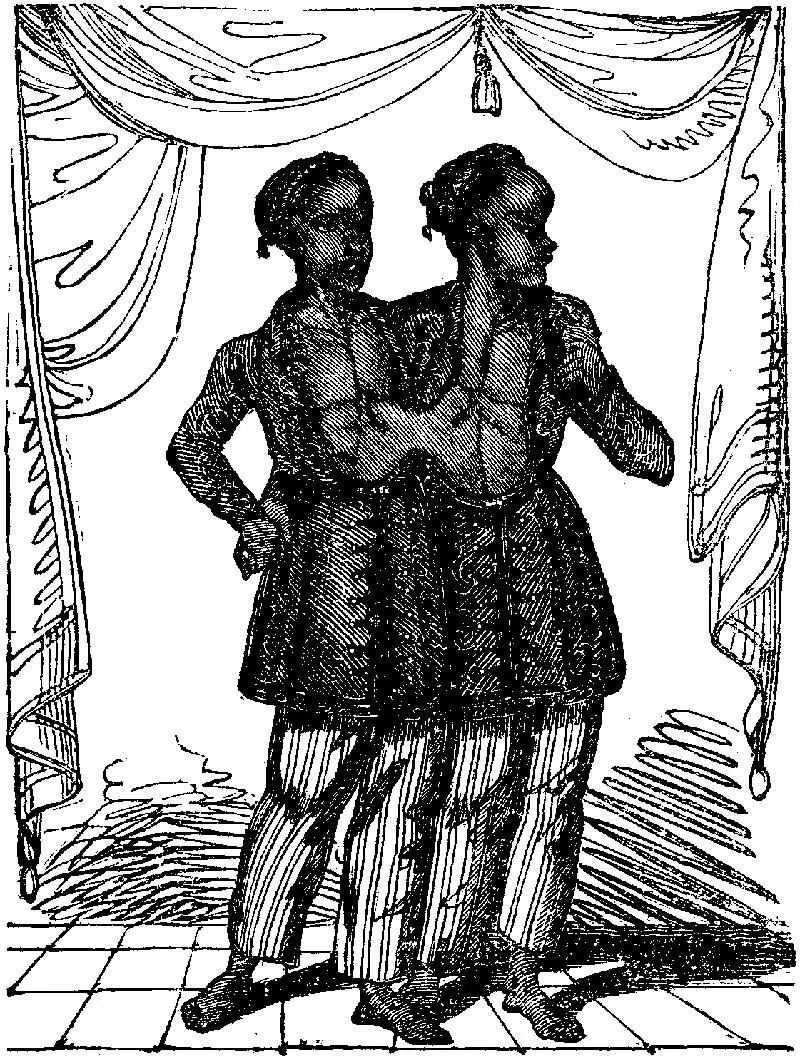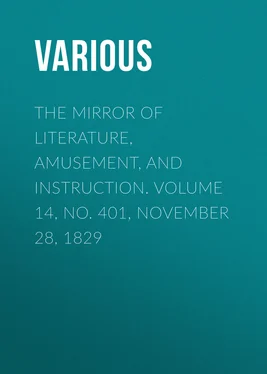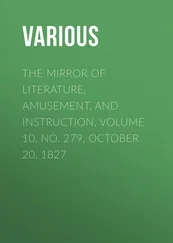Various - The Mirror of Literature, Amusement, and Instruction. Volume 14, No. 401, November 28, 1829
Здесь есть возможность читать онлайн «Various - The Mirror of Literature, Amusement, and Instruction. Volume 14, No. 401, November 28, 1829» — ознакомительный отрывок электронной книги совершенно бесплатно, а после прочтения отрывка купить полную версию. В некоторых случаях можно слушать аудио, скачать через торрент в формате fb2 и присутствует краткое содержание. Жанр: foreign_antique, periodic, Развлечения, foreign_edu, на английском языке. Описание произведения, (предисловие) а так же отзывы посетителей доступны на портале библиотеки ЛибКат.
- Название:The Mirror of Literature, Amusement, and Instruction. Volume 14, No. 401, November 28, 1829
- Автор:
- Жанр:
- Год:неизвестен
- ISBN:нет данных
- Рейтинг книги:3 / 5. Голосов: 1
-
Избранное:Добавить в избранное
- Отзывы:
-
Ваша оценка:
- 60
- 1
- 2
- 3
- 4
- 5
The Mirror of Literature, Amusement, and Instruction. Volume 14, No. 401, November 28, 1829: краткое содержание, описание и аннотация
Предлагаем к чтению аннотацию, описание, краткое содержание или предисловие (зависит от того, что написал сам автор книги «The Mirror of Literature, Amusement, and Instruction. Volume 14, No. 401, November 28, 1829»). Если вы не нашли необходимую информацию о книге — напишите в комментариях, мы постараемся отыскать её.
The Mirror of Literature, Amusement, and Instruction. Volume 14, No. 401, November 28, 1829 — читать онлайн ознакомительный отрывок
Ниже представлен текст книги, разбитый по страницам. Система сохранения места последней прочитанной страницы, позволяет с удобством читать онлайн бесплатно книгу «The Mirror of Literature, Amusement, and Instruction. Volume 14, No. 401, November 28, 1829», без необходимости каждый раз заново искать на чём Вы остановились. Поставьте закладку, и сможете в любой момент перейти на страницу, на которой закончили чтение.
Интервал:
Закладка:
Various
The Mirror of Literature, Amusement, and Instruction / Volume 14, No. 401, November 28, 1829
The Siamese Twins

The Engraving is an accurate sketch of this extraordinary lusus naturae , which promises to occupy the attention of the whole Town, and has already excited no ordinary curiosity among all ranks of the scientific and sight-loving. Deviations from the usual forms of nature are almost universally offensive; but, in this case, neither the personal appearance of the boys, nor the explanation of the phenomenon by which they are united, is calculated to raise a single unpleasant emotion. The subject is, therefore, not unfit for our pages, and the following descriptive particulars, which we have collected from various authentic sources, and our own observation, will, we are persuaded, be read with considerable interest:
The earliest account of the Siamese Twins is by Dr. I.C. Warren, of Boston, and was published in Professor Silliman's Journal of October last. They were received of their mother by Captain Coffin and Mr. Hunter, in a village of Siam, where the last-mentioned gentleman saw them, fishing on the banks of the river. Their father has been some time dead, since which they lived with their mother in a state of poverty. They were confined within certain limits, by order of the Siamese Government, and supported themselves principally by taking fish. Their exhibition to the world was suggested to the mother as a means of bettering their condition; to which proposition she acceded for a liberal compensation, and the promised return of her sons at a specific time. She accompanied them on board the ship and, as it was not about to sail for some time, she was invited to remain on board; but she declined, observing that she might as well part with them then as a few days hence. They were first exhibited at Boston, and subsequently at New York, in the United States. At Boston, Dr. Warren was appointed to report on them; and such of his observations as are free from anatomical technicalities, and otherwise adapted for our pages, will be found in the subsequent pages. In the meantime, we shall proceed with a more popular account of their present appearance, which has some of the most interesting characteristics of human nature.
They are two distinct and perfect youths, well formed and straight, about eighteen years of age, and possessing all the faculties and powers usually enjoyed at that period of life. They are united together by a short band at the pit of the stomach. On first seeing them, it may be supposed, so closely are their sides together—or rather, they over-lap a little—that there is no space between them. On examining them, however, they are found not to touch each other, the band which connects them being, at its shortest part, which is the upper and back part, about two inches long. At the lower front part the band, which is there soft and fleshy, or rather like soft thick skin, is about five inches long, and would be elastic, were it not for a thick rope-like cartilaginous or gristly substance, which forms the upper part of the band, and which is not above three inches long. The band is probably two inches thick at the upper part, and above an inch at the lower part. The back part of the band, which is rounded from a thickening at the places where it grows from each body, is not so long as the front part, which is comparatively flat. The breadth or depth of the band is about four inches. It grows from the lower and centre part of the breast of each boy, being a continuation of the cartilaginous termination of the breast bone, accompanied by muscles and blood-vessels, and enveloped, like every other portion of the body, with skin, &c. At present this band is not very flexible; and there is reason to believe that the cartilaginous substance of the upper part is gradually hardening, and will eventually become bone. From the nature of the band, and the manner in which it grows from each boy, it is impossible that they should be in any other position in relation to each other, but side by side, like soldiers, or coming up a little to front each other. Their arms and legs are perfectly free to move. The band is the only connexion between them; and their proximity does not inconvenience either; each of them, whether standing, sitting, or moving, generally has his arm round the neck or the waist of the other. When they take the arm from this position, so close are they kept together that their shoulders cannot be held straight; and the near shoulder of each being obliged to be held down or up, to allow them room to stand, gives them the appearance of being deformed; but two straighter bodies can scarcely be seen.
In their ordinary motions they may be said to resemble two persons waltzing. In a room they seem to roll about, as it were, but when they walk to any distance, they proceed straight forward with a gait like other people. As they rise up or sit down, or stoop, their movements are playful, though strange, not ungraceful, and without the appearance of constraint. The average height of their countrymen is less than that of Europeans, and they seem rather short for their age, even judging them by their own standard. They are much shorter than the ordinary run of youths in this country at eighteen years of age, and are both of the same height. In personal appearance there is a striking resemblance between them; this, however, is but on first impression, for, on closer examination, considerable difference will be observed. The colour of their skin and form of the nose, lips, and eyes, denote them as belonging to the Chinese; but they have not that broad and flat face which is characteristic of the Mingol race. Their foreheads are higher and narrower than those of their countrymen generally. Both are lively and intelligent; they pay much attention to what is passing around them; and are very grateful for any little attention that is paid to them. As a proof of their intelligence, it may be stated that they learned to play at Draughts very readily, and were soon able to beat those who had assisted in teaching them. Their appearance is perfect health. To their friends and attendants, and to each other, they are said to be much attached. They appear to be excellent physiognomists, for they read the countenance of the visiter readily, and are easily affronted with any contemptuous expressions. It is said they have not learnt any manual art beyond rowing a boat, but they can run and jump, and climb cracks and rigging with great facility. They are dressed in short, loose, green jackets and trousers, the costume of their country, which is very convenient, and allows the utmost freedom of motion, but does not show the form of the boys to advantage. With their arms twined round each other, as they bend down or move about, they look like a group of statuary. Dr. Warren, in his report, states that he never heard them speak to each other , though they were very fond of talking with a young Siamese, who was brought with them as a companion. They, however, appear to have a means of communication more rapid than by words. The point most worthy of remark, in regard to their actions and movements, is, that they seem, generally speaking, to be actuated but by one will; and that from whichever of them the volition of the moment proceeds, it seems imperative upon both. Occasionally, there is an exception to this remark—as, on the voyage from Siam to the United States, when one wanted to bathe, and the other refused, on account of the coldness of the weather, they quarrelled on the subject.
Each has a name of his own—the one, Chang , and the other, Eng ; but, when persons wish to address them as one—to claim their attention to anything, for example, or to call them—they are addressed as— Chang Eng .
Читать дальшеИнтервал:
Закладка:
Похожие книги на «The Mirror of Literature, Amusement, and Instruction. Volume 14, No. 401, November 28, 1829»
Представляем Вашему вниманию похожие книги на «The Mirror of Literature, Amusement, and Instruction. Volume 14, No. 401, November 28, 1829» списком для выбора. Мы отобрали схожую по названию и смыслу литературу в надежде предоставить читателям больше вариантов отыскать новые, интересные, ещё непрочитанные произведения.
Обсуждение, отзывы о книге «The Mirror of Literature, Amusement, and Instruction. Volume 14, No. 401, November 28, 1829» и просто собственные мнения читателей. Оставьте ваши комментарии, напишите, что Вы думаете о произведении, его смысле или главных героях. Укажите что конкретно понравилось, а что нет, и почему Вы так считаете.












